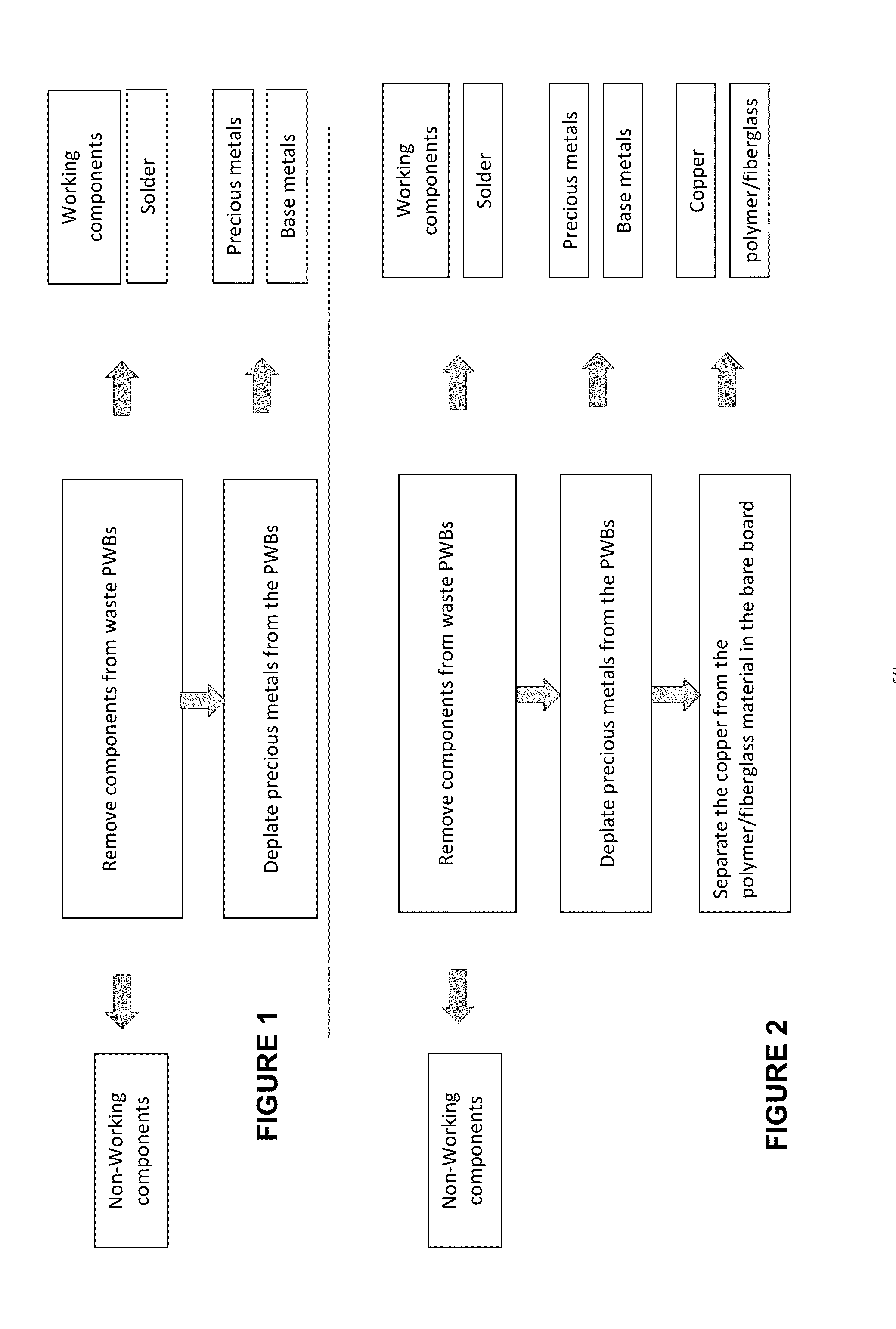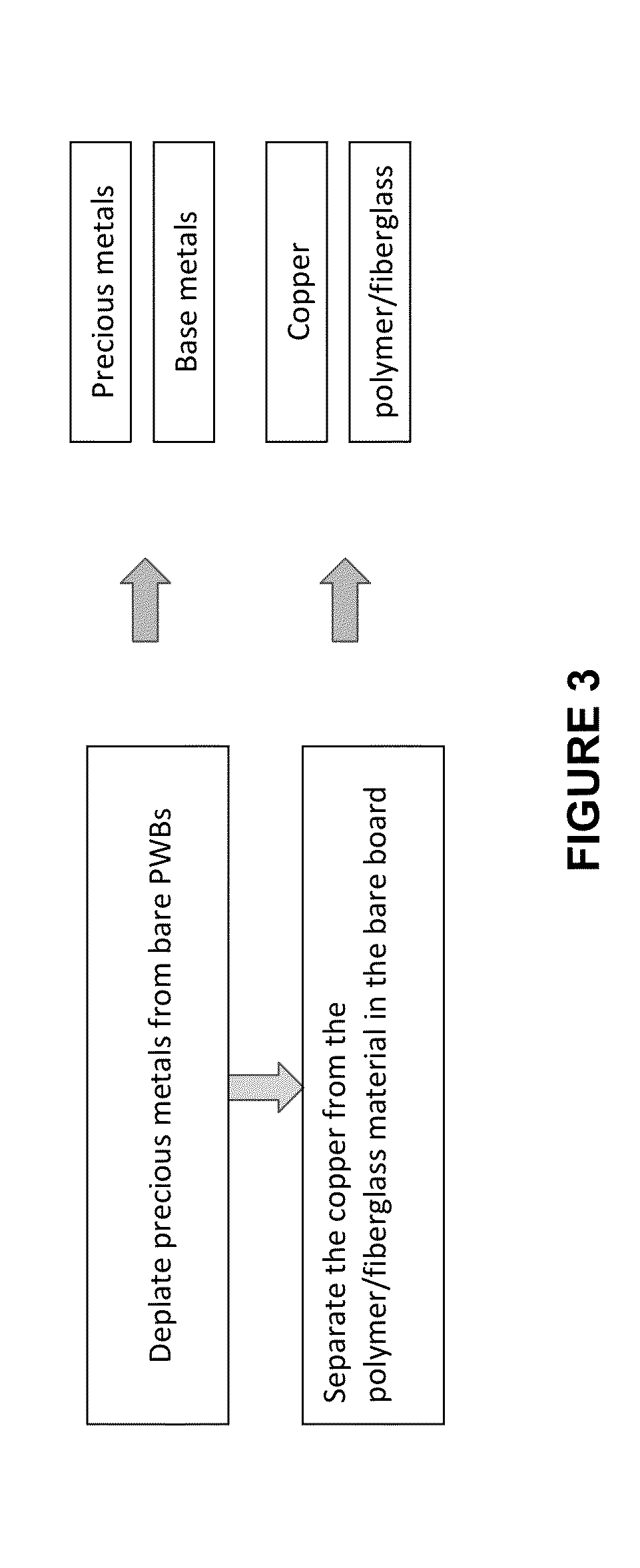Method for recycling of obsolete printed circuit boards
a technology of printed circuit boards and recycling methods, which is applied in the field of recycling printed circuit boards, can solve the problems of significant hazards pwbs are potentially difficult to process, and improper disassembly poses appreciable risks to the health and safety of people performing manual disassembly
- Summary
- Abstract
- Description
- Claims
- Application Information
AI Technical Summary
Benefits of technology
Problems solved by technology
Method used
Image
Examples
example 1
[0165]Three compositions were prepared, a 1:1 v / v HEDP / 30 wt % H2O2 solution (formulation A), a 1:1 v / v EDDS / 30 wt % H2O2 solution (formulation B), and a 1:1 v / v HEIDA / 30 wt % H2O2 solution (formulation C). Approximately 0.3 g of copper wire, nickel foil, granular tin, lead foil, aluminum wire, iron powder and granular zinc were individually and statically immersed in clean formulations A-C at 40° C. for 30 minutes. Following removal of the remaining solids, the solutions were subjected to inductively coupled plasma (ICP) analysis to determine the concentration of each metal (in ppm) in each solution. The results are summarized in Tables 1-3.
TABLE 1Results following immersion of materials in Formulation A.Sample toAl / Cu / Fe / Ni / Pb / Sn / Zn / Chemistrybe TestedpHppmppmppmppmppmppmppmHEDP / H2O2NA1ND1.810.070.16ND0.160.28HEDP / H2O2 Copper wire10.431477030.110.384.231.9639.93HEDP / H2O2Nickel Foil10.33.10.0810.45NDND0.26HEDP / H2O2Tin Granular10.111.440.170.12NDND0.19HEDP / H2O2Lead Foil10.663.190.110...
example 2
[0167]Compositions were prepared as described in Table 4 below. Copper wire, lead foil, granular tin, nickel foil, aluminum wire, iron powder and granular zinc were individually and statically immersed in each formulations at 40° C. for 30 minutes. Following removal of the remaining solids, the solutions were subjected to inductively coupled plasma (ICP) analysis to determine the concentration of each metal (in ppm) in each solution. The results are summarized in Table 4.
TABLE 4Results following immersion of materials in the listed compositions.Al / Cu / Fe / Ni / Pb / Sn / Zn / ChemistryppmppmppmppmppmppmppmFirst composition (remove Pb / Sn selectively)MSA4940ND109300186110402453236MSA + 1 wt % butyl carbitol (BC)45ND1531000745220042173324MSA + 1 wt % BC + 0.3 wt % sodium69.624.8639208.42372013840293.6molybdate dihydrateMSA + 1 wt % BC + 0.3 wt % suberic acidNDND79440021.6164002420625.2Second composition (remove Cu / Ni selectively)oxone (10 wt % in water)56.83030155600.82.1ND9630oxone (10 wt % in w...
example 3
[0170]An aqueous first composition was prepared, containing 250 mL of 70% methane sulfonic acid and 250 mL of deionized (DI) water. A waste video card NVIDIA model P118 was immersed in the first composition in silent leaching mode. The mounted components were detached in 4 days, gold plating was not affected, some pins on the detached components corroded, sludge and gas formation were not detected. The same solution was irradiated by ultrasound during 30 minutes but gave no noticeable result in detaching components.
[0171]An imitation of commercially available nitric acid based solder stripping solution was prepared, containing 145 mL of 70% nitric acid, 30 g of ammonium sulfamate, 1 g of benzotriazole and 40 g of ferric nitrate nonahydrate, balanced by DI water to 500 mL of total volume. A video card was subjected to silent leaching in this solution. The components detached in 20 minutes, the solution became green and a piece of steel, which is part of the video card, almost complet...
PUM
| Property | Measurement | Unit |
|---|---|---|
| frequencies | aaaaa | aaaaa |
| frequency | aaaaa | aaaaa |
| ultrasonic power | aaaaa | aaaaa |
Abstract
Description
Claims
Application Information
 Login to View More
Login to View More - R&D
- Intellectual Property
- Life Sciences
- Materials
- Tech Scout
- Unparalleled Data Quality
- Higher Quality Content
- 60% Fewer Hallucinations
Browse by: Latest US Patents, China's latest patents, Technical Efficacy Thesaurus, Application Domain, Technology Topic, Popular Technical Reports.
© 2025 PatSnap. All rights reserved.Legal|Privacy policy|Modern Slavery Act Transparency Statement|Sitemap|About US| Contact US: help@patsnap.com



